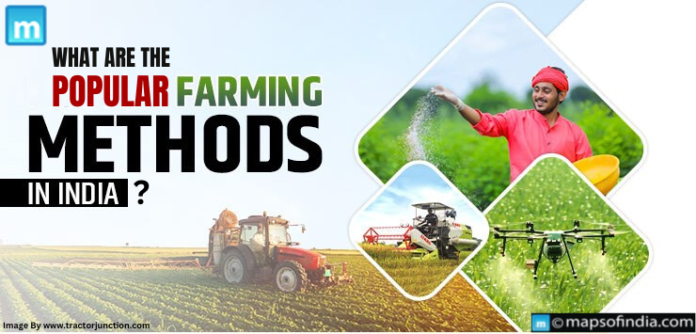There are many advancements in India’s farming methods, with technology advancements and the inclusion of traditional methods to encourage farmers to motivate new methods that help India advance in agricultural fields, increasing production and reducing time, with other advantages to go ahead from different countries.
Here are the popular farming methods followed in India:
• Subsistence farming
Subsistence farming is predominantly used in rural areas where farmers grow crops for personal consumption, which is a traditional method of farming with limited use of modern technology. This type of farming is highly used in states like Bihar, Jharkhand, Chattisgarh, Odisha, and a few parts of Uttar Pradesh due to small landholdings, lack of irrigation, and traditional farming methods.
• Organic farming
Organic farming has grown in popularity due to the increasing demand for chemical-free production, which emphasizes natural fertilizers, biological pest control, and crop rotation. organic farming is widely spoken in various regions of India and mainly in prominent states like Sikkim, Uttarakhand, Himachal Pradesh, and Kerala; Sikkim state has gained recognition for being the first fully organic state in India
• Precision farming
Precision farming Integrates technology for optimizing resource use like water, fertilizers, etc. This type of farming involves using GPS, data analysis, and sensors for effective farming practices, which are practiced with advanced agricultural practices in states like Punjab, Gujarat, Maharashtra, and Karnataka.
• Green revolution techniques
Green revolution techniques were introduced in the 1960s, focusing on a high-yielding variety of crops using modern inputs like pesticides, fertilizers, and improved irrigation methods. The primary beneficiaries of the green revolution techniques have been the states like Punjab, Haryana, and Western Uttar Pradesh.
• Genetically modified crops
Genetically modified crops are the most popular form of growing plants that have their DNA altered in a way that doesn’t occur through mating or natural recombination. These modifications aim to enhance helpful traits like resistance to pests, diseases, and environmental conditions and improve the plant’s nutritional content. Although this technique has benefits, there are a few concerns about this process, such as the ethical considerations, safety, and environmental impact that become drawbacks to this present agriculture system.
-
Vertical farming
Vertical farming grows crops in a vertically stacked layer, often used in urban areas where the land is scarce, and utilizes a controlled environment and artificial lighting to optimize crop growth and maximize yields. Vertical farming is famous in India, such as Hyderabad, Bangalore, Gurgaon, Delhi, Mumbai, and Pune.
-
Mixed farming
Mixed farming combines crop cultivation with livestock rearing on the same farm to create a closed-loop system that promotes sustainability and reduces dependence on external inputs. This type of farming is famous in Kerala, Odisha, Punjab, Haryana, Tamil Nadu, and Himachal Pradesh, and it has numerous benefits like increased productivity, reduced risk, sustainable practices, and improved livelihoods.
Although we are mentioning popular farming methods, it depends on factors like the types of crops grown, climate and soil conditions, farmer’s preferences and skills, and the availability of resources, which decide the type of farming methods used in a particular state along with advanced technology and traditional farming methods making a cohesion of change in the agricultural system.




